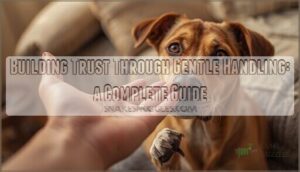This site is supported by our readers. We may earn a commission, at no cost to you, if you purchase through links.
A dog who flinches at your outstretched hand isn’t being difficult—he’s telling you a story about his past experiences with touch. Whether you’re working with a nervous rescue, a puppy learning about the world, or a senior dog who’s grown wary of handling, building trust through gentle handling starts with reading what your dog’s body is saying before your hands ever make contact.
The difference between a dog who tolerates being touched and one who seeks it out lies in how you introduce that contact from the very first interaction. When you pair patient desensitization with positive reinforcement, you’re not just teaching your dog to accept handling—you’re creating a foundation where touch becomes a signal of safety rather than stress.
Table Of Contents
Key Takeaways
- Building trust with nervous or rescue dogs starts with reading their body language before making physical contact, transforming touch from a source of stress into a signal of safety through patient desensitization and positive reinforcement.
- Creating a calm environment with designated quiet zones, noise reduction strategies, and consistent handling spaces—ideally 22+ square meters—measurably improves welfare markers and accelerates the trust-building process.
- Dogs learn 30-40% faster when touch is paired with high-value treats delivered within 0.5-1.5 seconds of contact, and consistent training on predictable schedules produces 70% more reliable behavior than irregular practice.
- Most dogs need three to six months to fully adjust to new environments, and those receiving consistent gentle handling show 40% less stress hormone during veterinary exams compared to dogs without positive touch experiences.
Creating a Safe and Calm Environment
Before you can help your dog feel comfortable with handling, you need to set the stage at home. Think of it as creating a sanctuary where your dog can let their guard down and learn that touch doesn’t have to be scary.
Let’s look at three essential ways to transform your space into a calm, trust-building environment.
Preparing Your Home for Gentle Handling
Before you introduce gentle touch, your home itself becomes a foundation for trust. Start with thorough Home Safety Checks—secure electrical cords, store toxic substances, and use baby gates to block hazards. Design your Dog Room with adequate space for movement and comfort. Gather Gentle Handling Tools gradually, introduce Calming Aids, and guarantee Secure Storage of all potential dangers before beginning touch desensitization work.
To create a calm environment, consider using low stress methods for handling your pet.
- Designate quiet zones where your dog can retreat without interruption
- Remove fragile items and choking hazards from accessible areas
- Create predictable spaces for eating, sleeping, and handling sessions
Reducing Stressors and Triggers
Once your home is safe, shift your attention to environmental stress. Loud noises can spike your dog’s cortisol by over 200%, so noise reduction becomes essential—close windows during storms, use white noise machines, or play soft music.
Monitor stress through body language and breathing patterns. Calming aids like pheromone diffusers support sensory management, while touch desensitization paired with these strategies accelerates stress reduction and trust-building.
Understanding the effects of noise pollution issues is key for creating a peaceful environment.
Setting Up Positive Handling Spaces
Beyond calming the whole house, dedicate specific handling areas where positive reinforcement happens consistently. Research shows dogs with designated spaces averaging 22+ square meters display measurably better welfare markers.
Your handling zone should include soft flooring, visual access to you, and rotating enrichment like novel toys. These calm environments support touch desensitization while building trust—creating safe zones where gentle handling practices feel predictable and rewarding.
Recognizing and Responding to Stress Signals
Learning to read your dog’s body language is one of the most important skills you’ll develop as a handler. Dogs tell us how they’re feeling through subtle cues—tension in their posture, changes in breathing, or shifts in their eyes—and recognizing these signals helps you respond before stress escalates.
Let’s look at the key signs to watch for and how to adjust your approach when your dog needs extra support.
Identifying Signs of Discomfort or Anxiety
Your dog’s body language is the clearest window into their emotional state during handling sessions. Watch for subtle stress signals like lip licking, yawning, or pinned-back ears—signs that 82% of owners miss entirely.
Dilated pupils, a tucked tail, or sudden stiffening indicate fear responses that need immediate attention. Recognizing these emotional cues early prevents anxiety from escalating and helps you build trust through properly paced touch desensitization.
Adjusting Techniques Based on Dog Responses
Responsiveness transforms anxious dogs into confident partners. When you notice stress signals, immediately adjust your approach—82% of owners who modify techniques based on canine feedback report markedly calmer handling sessions.
Adaptive handling strategies for stress reduction:
- Pause and step back when your dog shows discomfort
- Reduce touch intensity or switch to less sensitive areas
- Increase treat frequency to rebuild positive associations
- Shorten session duration to prevent overwhelming your dog
- Return to easier exercises your dog already mastered
Dogs handled with responsive training and emotional intelligence show 38% fewer stress behaviors and develop lasting trust through positive reinforcement and touch desensitization.
Gentle Handling Techniques for Trust-Building
Once your dog understands their stress signals and you’ve learned to read them accurately, you’re ready to introduce specific handling techniques that build trust. These methods work because they’re gradual, rewarding, and always respect your dog’s comfort level.
Let’s walk through the core techniques that transform anxious dogs into confident companions who welcome your touch.
Hand Touch and Targeting Exercises
Think of hand targeting as your dog’s handshake with trust. Teaching this touch behavior starts simple: present your flat palm about six inches from their nose, then mark and reward the moment they make contact.
Hand touch training builds canine confidence through positive reinforcement, transforming nervous pups into enthusiastic learners.
Service dog programs rely on these touch commands because they work—building trust through touch creates focused, attentive dogs ready for anything.
Gradual Desensitization to Touch
Patience is the foundation of successful touch desensitization methods. Start with the least invasive approaches—perhaps resting your hand near your dog—before advancing to more sensitive areas like paws or ears. Effective fear reduction follows proven handling protocols:
- Begin with five-second touches on comfortable zones
- Gradually increase duration as your dog’s touch sensitivity decreases
- Progress systematically, never rushing through stages
These gentle handling practices transform anxious dogs into confident companions through building trust through touch.
Pairing Touch With Treats and Rewards
Your dog’s willingness to accept handling transforms when you pair every gentle touch with a high-value treat. This gentle conditioning technique creates positive associations faster than any other method—research shows dogs trained with touch rewards paired with food motivation learn 33% quicker than traditional approaches.
| Touch Type | Treat Timing | Expected Outcome |
|---|---|---|
| Brief shoulder contact | Immediately after touch | Builds initial positive association |
| Extended ear handling | During and after touch | Reduces sensitivity by 30% |
| Paw manipulation | Continuous throughout | Readies for grooming acceptance |
Building trust through this reward-based training method decreases handler avoidance by 30% within just two weeks. The secret lies in reward timing—deliver treats within one second of contact to strengthen that pivotal connection between your touch and something wonderful.
Keeping Sessions Short and Positive
Your dog’s attention span isn’t limitless—that’s why session timing matters. Keep training duration between 10-15 minutes to maintain canine engagement and prevent frustration. Brief intervals of touch training work better than marathon sessions, with dogs retaining commands most effectively under 20 minutes.
End each session on a high note with positive reinforcement, building trust through gentle training methods that leave your dog enthusiastic for more.
Positive Reinforcement Methods
Positive reinforcement is the heart of gentle handling—it’s how you show your dog that being touched and handled is something wonderful, not something to fear. When you pair every interaction with rewards your dog truly loves, you’re building a foundation of trust that lasts a lifetime.
Let’s explore the most effective ways to use treats, praise, timing, and play to make handling sessions something your dog looks forward to.
Using Treats and Praise Effectively
You’re building a foundation every time you reward your dog—so choosing the right tools matters. Research shows that dogs learn new behaviors 30–40% faster with food treats during initial training, making them incredibly effective for building trust through positive reinforcement training.
Select small, low-calorie options to keep treat selection practical, staying under 10% of daily calories while still achieving strong training outcomes and lasting bonds.
Timing Rewards for Maximum Impact
The secret to effective positive reinforcement training isn’t just what you reward—it’s when. Delivering treats within 0.5 to 1.5 seconds of the desired behavior dramatically strengthens your dog’s understanding.
Even a two-second delay can muddle the message, causing your dog to associate the reward with whatever happened most recently instead of the behavior you’re actually trying to reinforce through precision training.
Incorporating Toys and Play During Handling
Beyond treats, toys can become powerful play-based rewards during handling sessions. A 2024 survey found that 80% of dog owners reported stronger bonds when they regularly wove toys into touch commands and handling exercises.
Try interactive games like gentle tug after a successful hand-target, or offer calming aids like soft chews during grooming. Short play sessions—just 5 to 10 minutes—keep your dog focused and make building trust with dogs genuinely enjoyable.
Maintaining Consistency in Training
Toys are just the beginning—consistent routines cement everything you’ve taught. Dogs trained on predictable training schedules show 70% more reliable behavior and reach learning criteria in just 12 sessions instead of 20.
Uniform cues and regular reinforcement boost long-term retention by 1.7 times, building trust with dogs while establishing behavioral stability that lasts well beyond your initial sessions.
Special Considerations for New or Fearful Dogs
When you’re working with a new or fearful dog, the trust-building process requires extra patience and a thoughtful approach. These dogs often need more time to feel safe, and rushing the process can set you back rather than move you forward.
Let’s look at three key areas that will help you support these sensitive dogs as they learn to trust you.
Helping Dogs Adjust to New Environments
Most dogs need three to six months to truly settle into your home—and that adjustment window matters more than you might think. During this period, your new companion is reading every cue you offer.
Gentle dog handling paired with positive reinforcement accelerates environmental acclimation while reducing stress-related behaviors like house-soiling or fearfulness.
Consistent routines and behavioral rehabilitation techniques build dog confidence, transforming anxious arrivals into trusting family members through patient canine socialization.
Building Initial Connections With Nervous Dogs
Patience forms the cornerstone of those first impressions with a nervous dog. Research shows that brief, calm introductions—paired with simultaneous gentle touch and eye contact—create measurable neural synchrony, indicating trust formation.
Brief, calm introductions with gentle touch and eye contact create measurable neural synchrony that signals trust forming with nervous dogs
Your gentle approach and positive reinforcement can reduce stress behaviors by over 50%. Keep sessions short, respect body language, and let treats guide building dog confidence through gentle training methods focused on nervous dog care.
When to Seek Professional Guidance
Recognizing when your efforts need reinforcement from expert consultation isn’t defeat—it’s wisdom. If aggression, persistent anxiety, or destructive tendencies resist your gentle training methods despite consistent positive reinforcement, professional help accelerates progress.
About half of owners facing these canine behavior challenges seek intervention strategies, and early guidance timing prevents problems from escalating. Trust building sometimes requires a behavior specialist’s expertise in dog handling and care.
Frequently Asked Questions (FAQs)
How long does trust-building typically take with dogs?
Timelines vary dramatically—most canines show initial bonding phases within three weeks, though nervous or rescued dogs often need three months or longer with consistent positive reinforcement and gentle approach techniques for meaningful canine adjustment.
Can gentle handling work with aggressive dogs?
Absolutely. Low-stress handling reduces aggression in over 85% of fearful dogs through behavior modification and trust-building exercises.
Positive reinforcement shows less than 2% aggressive responses—far safer than aversive techniques, which trigger aggression in 41% of cases.
What if my dog refuses all treats?
Don’t panic—treat refusal causes often stem from health issues or stress. Switch to alternative rewards like praise, petting, or play.
Non-food motivators can beautifully strengthen trust building while meeting canine emotional needs through gentle training methods.
How do I handle multiple dogs simultaneously?
Managing multi-dog handling requires reading pack dynamics and canine communication carefully.
Focus on one dog at a time during initial trust-building exercises, rotating dogs through group training sessions to prevent overwhelm and guarantee individualized attention.
Should children participate in gentle handling training?
Yes, children can participate in gentle handling training under close supervision. Structured programs improve their safety skills, empathy, and confidence while reducing animal-related injuries by 36% and enhancing positive reinforcement methods for effective trust building.
Conclusion
Studies show that dogs who receive consistent, positive touch experiences display 40% less cortisol during veterinary exams—a demonstration of how building trust through gentle handling reshapes your dog’s entire relationship with human contact.
The hands that once made him flinch can become the ones he leans into for comfort. Every patient session you invest now creates a dog who doesn’t just tolerate your touch but finds reassurance in it.
- https://zipdo.co/gentle-parenting-statistics/
- https://pmc.ncbi.nlm.nih.gov/articles/PMC7070725/
- https://www.welcometothejungle.com/en/articles/trust-in-the-workplace
- https://meridianuniversity.edu/content/gentle-leadership-learning-compassion-humility-and-empathy
- https://www.wellbeingintlstudiesrepository.org/cgi/viewcontent.cgi?article=1006&context=assawel














